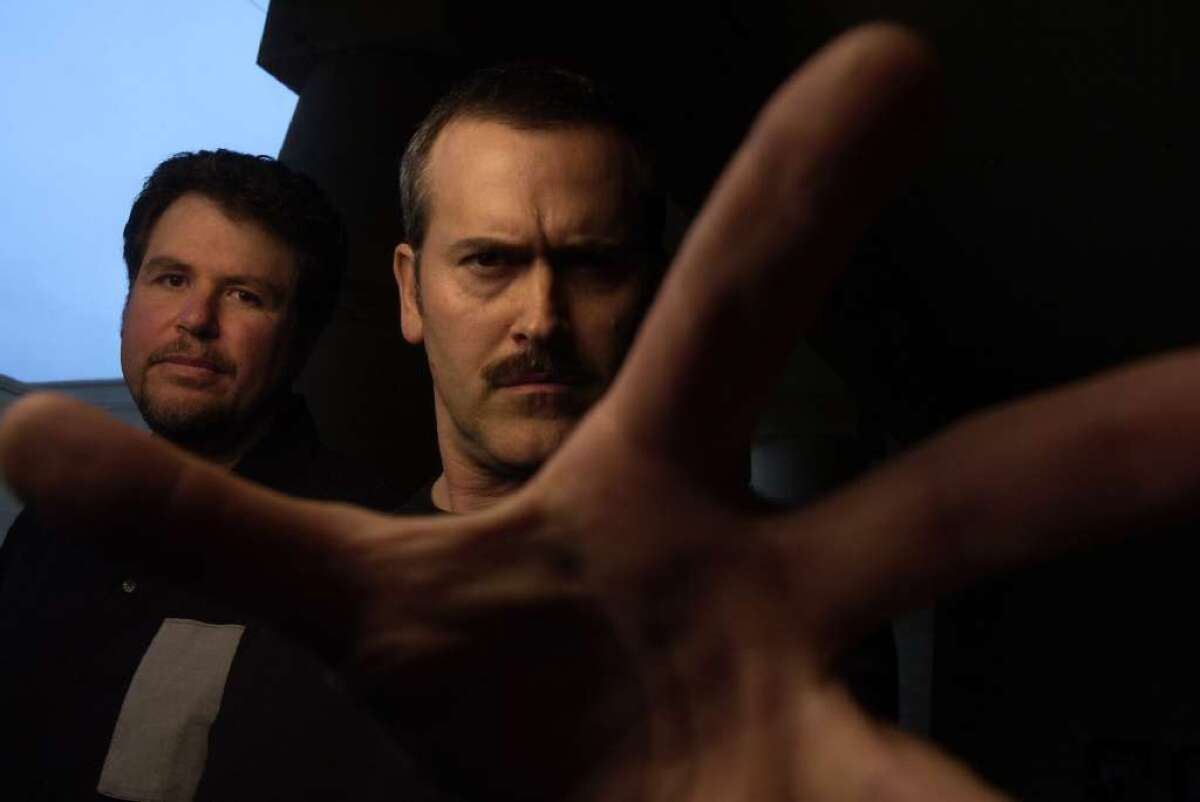In an age of comic-book blockbusters and viral sensations, whatever happened to the cult movie?
Anyone who lived through the heyday of the video store era in the ’80s and ’90s will remember that in any home video establishment worth its salt – or its late fees – you’d find a section specially devoted to cult movies.
Often studiously curated by a pasty but ardently film-loving clerk, the cult section was an eclectic island of cinematic misfit toys, filled with movies that had missed – or just as often spurned – mainstream success but found a devoted following among a select group of acolytes. Outrageously tasteless comedies like “Pink Flamingos” and “Eating Raoul.” Twisted, often ultra-gory horror movies like “Re-Animator” and “I Spit on Your Grave.” Sci-fi oddities like “Dark Star” and “Barbarella: Queen of the Galaxy.” And films like “Repo Man” and “Eraserhead” that defied any categorization whatsoever.
The definition of cult was always an elastic one and could apply to movies independent of their quality or provenance — a film like “This Is Spinal Tap,” a classic mockumentary about dim-witted rockers, could sit on the shelf right next to “The Beastmaster,” a sword-and-sorcery fantasy epic about a warrior who can communicate telepathically with animals. But the one thing every cult film has is a deep and sometimes irrational zeal — if not on the screen, then certainly in its audience.
The cult film may have been overlooked by audiences the first time around, but it demands to be shared by the few who did catch it – by word of mouth, by hand, by physically putting someone in front of a screen. It’s a slow burn, rather than a quick flare, but an all-encompassing one.
Those old video stores have virtually all disappeared now, of course, along with many of the independent movie theaters that, in decades past, drew steady crowds to such “midnight movies” – all of it swept away in the transition to a fully digital, on-demand world. And the cult movies themselves? It seems they’re in danger of going extinct as well.
In today’s fragmented, ever-churning pop culture ecosystem, the long tail of home video that once gave oddball movies a shot at a glorious cult afterlife has shortened to the point of vanishing. With even big-budget commercial films often struggling to break through the endless clutter of content, the challenge for smaller, quirkier fare is that much harder.
Even when a particular offbeat film – say, “The Babadook” or “It Follows” – manages to catch a viral wave, it is almost instantly overcome by the next fresh piece of “must-watch” entertainment that demands your already overtaxed attention. Instead of a long tail, we now have a collective case of incurable cultural ADHD.

Writer-director Don Coscarelli has witnessed the rise and decline of the cult movie up close over the course of his career. In a very real way, his life has been defined by that arc.
In 1979, Coscarelli wrote and directed a surrealistic horror film called “Phantasm” about a sinister undertaker who turns dead people into dwarf zombies who do his bidding – a cult premise if ever there was one. Sure enough, “Phantasm” became a major cult hit, eventually spawning four sequels. But while some of Coscarelli’s peers, like “Evil Dead” director Sam Raimi, went on to mainstream success, Coscarelli never quite shook the label of cult filmmaker. At this point, he wears it like a badge of honor.
“A lot of people look down on that cult label,” Coscarelli said over lunch in Los Angeles on a recent afternoon. “But I equate cult with passion, and passion is cool.”
To further explain what the admittedly slippery concept of cultdom means to him, Coscarelli referred to a friend and fellow cult-movie legend, “Evil Dead” star Bruce Campbell, who played an elderly, ancient-mummy-battling Elvis Presley in Coscarelli’s 2002 horror-comedy “Bubba Ho-Tep.”
“Bruce told me a few years ago that he could walk past a line of people and 99 people would not know who he was, but the last person would wet himself,” Coscarelli said. He laughed. “I thought that sort of summed up the whole deal.”
Now 62, Coscarelli still manages to get movies made, including, most recently, a fifth and final installment in the “Phantasm” series, “Phantasm: Ravager,” which he produced and co-wrote. (That film and a remastered version of the original “Phantasm” were recently released on Digital HD and VOD, with Blu-ray editions slated for December 6.) But the economics have grown far more forbidding. His last directorial effort, the 2012 sci-fi-zombie-comedy “John Dies at the End,” earned generally positive reviews but grossed just $141,951 in its limited theatrical release.
“When I think back about the VHS and early DVD days, anybody could make any movie and take it to one of the film markets and get $500,000 to $1 million back for any piece of junk,” he said. “Nowadays it’s such a battle to break even.
“The clutter has changed everything,” he continued. “All the old modes of curation are going away. Marketing movies from a more modest level and punching through – it’s really difficult.”
Indeed, as the studio system has reengineered itself almost entirely around mass-appeal tentpole movies, it’s become increasingly difficult to make and market the kind of idiosyncratic, creatively risky projects that, in years past, could sometimes develop cult followings. The result has been an exodus of many edgier writers and directors to the relatively more welcoming arenas of TV and streaming services like Netflix and Amazon.
In comedy, as in horror, the cult movie is in danger of becoming a thing of the past. To find the last offbeat comedy that truly came out of nowhere and organically developed a major cult following, you’d probably have to reach all the way back to Jared Hess’ 2004 sleeper hit “Napoleon Dynamite” or 2003’s unintentional comedy “The Room.”
Speaking to The Times last month before the opening of his most recent comedy, “Masterminds,” Hess recalled how his deadpan directorial debut about a high-school geek with delusions of grandeur, shot in Idaho on a shoestring budget of less than $500,000, slowly blossomed into a phenomenon.
“It was before Facebook and Twitter, so Fox Searchlight did true word-of-mouth screenings for the film,” Hess said. “They’d take it all over – not just New York and L.A. but places like Olathe, Kansas – and screen it for free, and they’d give people a ‘Vote for Pedro’ T-shirt and a tube of Chapstick. Suddenly people were talking about the film before it came out.”
Generating that kind of buzz should theoretically be even easier in the age of social media, but Twitter and Facebook represent such a pell-mell cacophony of voices they thwart any coherent or sustained conversation. Meanwhile, with entertainment consumption in the digital era being such a solitary experience, the days of physically handing a friend a VHS or DVD copy of a beloved movie to watch, like making someone a mixed cassette tape of your favorite songs, is a distant memory.
As Hess sees it, there was something more personal and durable about the way passions for a particular film could be passed from one viewer to another even a decade ago.
“It was a more intimate experience,” Hess said. “If you went and saw a movie on your own, you kind of felt like you discovered it. You had ownership of it, in a way.”
Hess continues to make comedies for the big screen but, like many whose sensibilities are a little more skewed, he has also started to shift his focus toward TV and the streaming services, where the pressure to attract a mass audience is inherently lower and the tolerance for risk is higher.
“You see so many filmmakers gravitating toward television and places like Netflix,” he said. “You’re just able to kind of pinpoint the audiences a little better. You can do things on a smaller scale and cater to that audience.”
Even as the changing economics and distribution models of the film industry have imperiled the cult movie, the very idea of “cult” has shifted – and, in a paradoxical way, gone mainstream.
Comic books, once largely the province of a relatively small subculture of fans, have become the bread and butter of Hollywood. Overflow crowds routinely pack into Comic-Con’s Hall H for panels on genre movies and TV series that, in years past, would have been considered fringe-y. Zombies, formerly the stuff of B-grade horror movies and Fangoria magazine spreads, are now the stars of one of the biggest shows on TV, AMC’s “The Walking Dead.”
“Everyone is used to seeing zombies now, and it’s not, like, ‘Oh, my God, gross, look at his intestines,’ ” said Chela Johnson, vice president of marketing at Lionsgate, which recently released a series of deluxe, limited-edition Blu-rays of cult ’80s Vestron Video horror films like “Blood Diner,” “Chopping Mall” and “Waxwork.” “Before, you were just a weirdo – now it’s the everyday person that sees this stuff.”
Earlier this month, one of the culty-est of cult movies, 1975’s campy horror-comedy musical “The Rocky Horror Picture Show,” was remade into a prime-time event on Fox. To those who once proudly defined themselves by their appreciation for such a subversive underground phenomenon, seeing millions of people tune into a relatively neutered network TV version of “Rocky Horror” may have felt like the final nail in the coffin of the very notion of “cult.”
“Every time that commercial came on, it was like, ‘Ugh,’ ” Johnson said with a laugh. “Now we have to share with the mainstream people.” (That the ratings, in the end, proved underwhelming may provide a measure of consolation to some old-school “Rocky Horror” devotees.)
With all that said, despite the changing industry dynamics and shifts in public tastes, as long as passion, weirdness and the instinct to gather with like-minded people continue to exist in the world, declarations of the death of the cult movie may be premature.
For what it’s worth, Netflix’s streaming service does have a section devoted to cult movies. Granted, it’s fairly limited and includes a few highly debatable selections, like “The Human Centipede 3,” “Sharknado 2: The Second One” and “Children of the Corn: Genesis” – selections that at times seem more likely to have been spat out by a computer algorithm than a living, breathing lover of movies.
Still, Coscarelli sees some reasons to be optimistic. “It’s that old saying: It’s the best of times, it’s the worst of times,” he said. “There are a lot of passionate cult fans who are burning to express themselves. You could easily shoot a movie on an iPhone 7. Maybe there will be different kinds of cult movies that people will be watching.”
He paused and gave a small, sad shrug. “Or maybe there won’t be.”
Twitter: @joshrottenberg
More to Read
Only good movies
Get the Indie Focus newsletter, Mark Olsen's weekly guide to the world of cinema.
You may occasionally receive promotional content from the Los Angeles Times.











